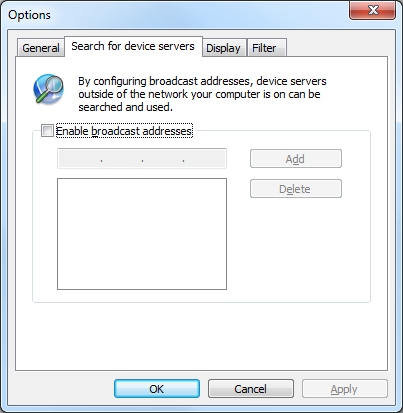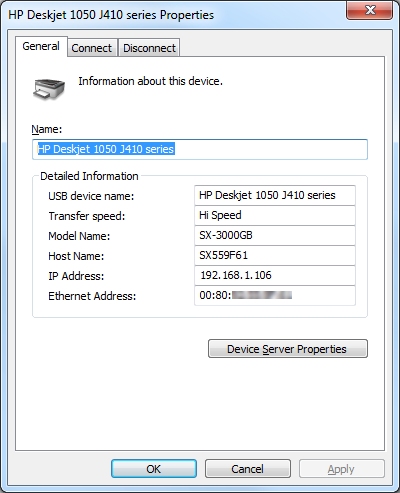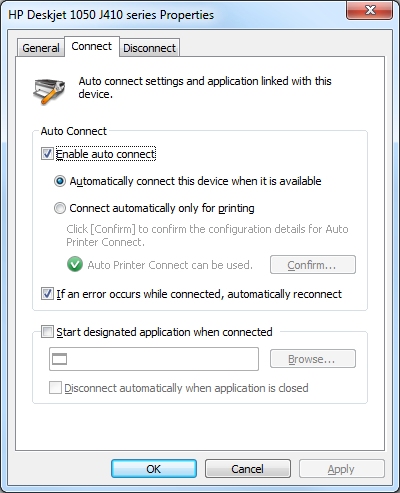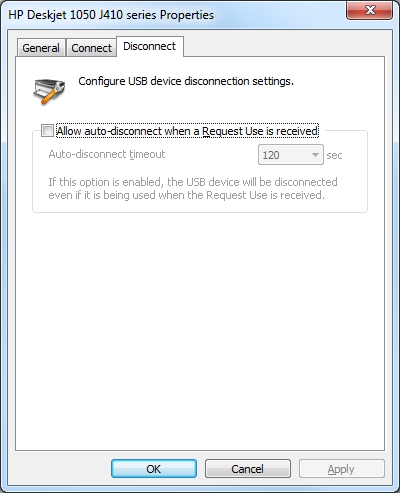Silex SX-3000GB
The testing procedure for this product is to connect different devices and see if and how they work. How will we find the devices on our computers? Is it through some sort of network browsing or how does it work?
Well I can really say I was amazed. Hang in there to find out!
First off we need to install the software and after that is installed we’re greeted by SX Virtual Link. A window that shows all devices connected to the device server and also available on the network for all computers connected to it.
Here we can see that we have a HP Deskjet 1050 J410 printer, which also is recognized as a “Multifunction device”. Furthermore we have a Kingston DataTraveler 109 USB memory connected to the second USB port on the device server, this is recognized as a “Storage device”.
The rest of the information; Host Name, Model Name, IP Address and Ethernet Address corresponds to which device server these devices are connected to.
First off we take a look at the settings for the SX Virtual Link itself. We can configure quite a bit in the software and one of the main features you would want to check is “Launch SX Virtual Link at Windows startup” as this makes sure the SX-3000GB device server always is available when you need it. If you also want new devices to directly connect you can check “Automatically connect newly discovered USB devices”, which makes it possible to skip opening up the main window and click connect on every new device.
Please note! It might possibly be dangerous to do this as USB devices can be configured with malicious self-starting scripts which could potentially destroy both your computer, but even worse your company if you use such a device in your business. However, if you make sure only you and trusted employees/family members have access to this device server you should be safe.
Furthermore you can configure the software to find device servers outside the network your computer is on, this is useful for business with larger networks. If you have several device servers on your network and want to filter out a few or even all but one, that is of course possible too. A simple and perhaps unnecessary feature, but hey it could be very useful and Silex thought of it, awesome!


Alright if we head back to the main window and right click the printer and choose properties we can go through some configuration specific to our printer. We can find the same information as on the main window, but we can also rename the device to something else.
Further we can configure the auto connect feature, do we want auto connect? Well sure for a printer, that would be very useful. However, which kind of auto connect do we want? I guess for a printer which should be shared with more than one computer, we should use “Connect automatically only for printing” as this only occupies the printer connection when you’re printing something and then disconnects making it available for others to use.


This is one of the minuses of a product like this and that isn’t specific for just printers, but for all products you connect to the device server. Only one connection at a time for each and every USB peripheral that you connect through the device server.
However, Silex minimizes the annoyance of this by letting you use the feature “Connect automatically only for printing” or on the disconnect tab, “Allow auto-disconnect when a Request Use is received”. The first feature only connects to the printer when you need to print, the second feature makes the printer always connected and releases it when someone else needs it.
Which of these features suites you best is of course up to you, but I noticed that the first feature; “Connect automatically only for printing” seems to work the best so far.
Alright so how do we actually connect, how do we find the USB devices on our computer? Well, if you don’t have the SX Virtual Link software installed, you don’t – period.
Ok, so what if we have it installed? Well then you find the devices at first in the main window and only after “connecting” to a device it is available for you to use on your computer. This is where the amazement part comes in. When you do connect to a device that is connected to the device server, your computer actually sees the device as a real USB device, as if the device was directly connected to your computer.
There is no, really none, network browsing needed. You don’t need special drivers, no need to configure a whole lot. No need to define IP numbers on your printer or anywhere else. No NOTHING.
In the case of our printer, when I clicked “connect” in the main window of SX Virtual Link, the printer was ready to be used just like if it was connected through USB directly on my computer. There was no difference at all and I could use all functions as before; printing, scanning, checking ink levels.
I can honestly say, I sat and was amazed for a good 10 minutes of how easy and extremely well working this device server, SX-3000GB, is. It is as simple as connecting a USB mouse to a computer, it just works.
If we move on to other devices, as you could see in the main window I had a USB memory plugged in as well, there was no difference at all using that as a regular USB device. You can easily exchange that for a USB hard drive of 2 terabytes, no difference in accessibility.
I also tried hooking up a mouse, connected to it and I could control my machine over the network with a network mouse. How awesome isn’t that? Ok, that is a feature I don’t really need, but hey it works.
So what can I say about the SX-3000GB USB to Ethernet bridge from Silex? Well it is a great and very easy to use product. In Sweden we have it available for around 900 Swedish kronor which translates to at the time of writing this review, to around EUR €100, USD $150, GBP £90. For the features given, this product is a must for everyone that has at least one USB product that they would like to share with more than one computer in an easy way.
I would like to thank Silex for sending out this review sample, even if the product itself has a few years on its back. But it is still available on the market which I believe it should be at least until all needed USB products have a network interface, which probably would never happen.
The SX-3000GB is just perfect!






























